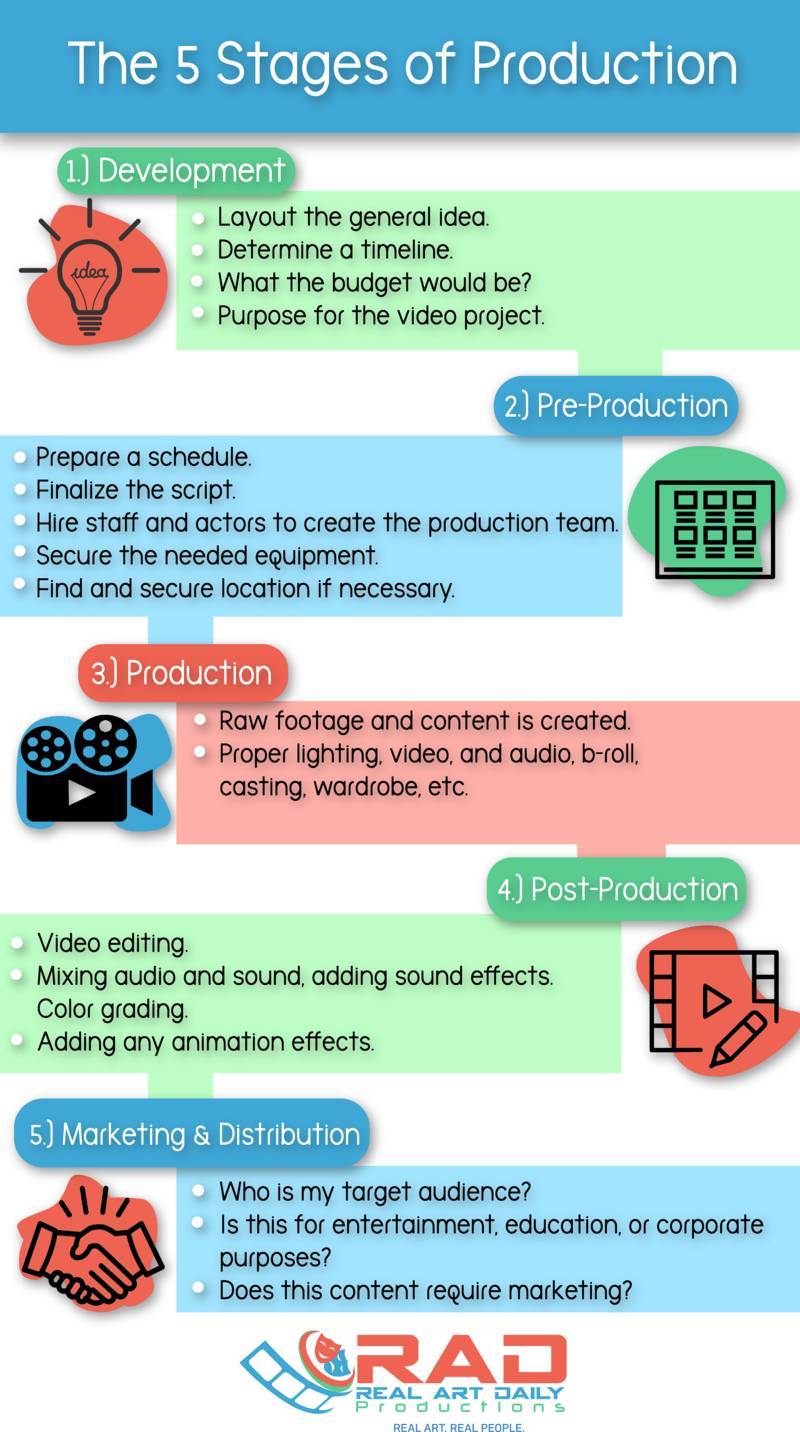5 Stages of Video Production Process That You Need to Know

Are you intrigued about the world of film and production but not involved in it? This article will help you gain better knowledge of the stages of video production
Are you a business owner who wants to use videos to promote your products and wants to learn about various video production stages? Are you someone with a beautiful idea but have no idea how to get started in the video production process? No matter what your reason, read on to understand about the phases of the production process.
What we’ll cover:
- What Does Video Production Mean?
- Stages of Video Production
What Does Video Production Mean?
At its most basic definition, video production is the process of creating video content, starting with development of the story and finishing with the distribution of the video.
Video content is one of the most powerful forms of media in the modern world.
A production team produces content within a video production company. A video production company can coexist as a movie production company, but they are not technically the same thing.
Video production companies focus on creating any digital content. i.e. films, animation videos, tv shows, corporate videos, etc.. Essentially, they are involved in every step of the process as they help develop, produce and edit content.
What are the Stages of Video Production?
Video production is broken down into three stages: pre-production, production, and post-production. However, breaking it down into only three stages does not account for the full breadth of what truly goes into the process.
To get a complete idea of what it takes to produce content, read about the five key video production phases

Development
Development is the first stage. Without this stage, creating any type of project would be unattainable. For those who follow the three-stage model, development is folded into the pre-production stage.
This stage is essentially the birth of the project, where it is conceived and visualized. Development includes writing drafts of the script and conversations between the production company and the client.
Common steps include:
- Lay out the general idea.
- Write a draft of the script
- Create an initial plan on how to execute the idea.
- Determine a timeline.
- Obtain an accurate idea of what the budget would be.
To understand the requirements of the project, a production company must ask client-specific questions, such as:
What is your purpose for this video project? Each story should have a purpose. Having a purpose in your work will show the audience that the time and care was taken to make the project the best it could be and will more likely be well received.
The purpose of a project changes on an individual basis. Some projects exist for satire; others to show diversity globally; and some make statements to show things that are not traditionally shown in the media.
Who is the target audience? Knowing your target audience increases the chance of a project’s success immensely. Although many creators create for themselves, they still aspire to the end goal of having their project reach a wider audience.
Knowing your target audience will ultimately shape your project. More importantly, knowing your target audience is crucial to understanding how to market your final video.
An exercise that is commonly used to discover your target audience is the creation of personas. Personas are fictional characters representing the user who is likely to consume the content and are often used in user design.
What feeling are you trying to evoke in your viewers? Do you want your viewers to relate to the story? Do you want them to feel sadness for the characters? Do you want to incite social change deep within the audience? Narrowing down what feeling you are looking to incite in your audience will deepen the relationship between the content and the viewer.
Are you trying to make a social statement? Are you trying to put emphasis on discrimination, gender identity, or sexuality? Are you trying to call out the lack of diversity in the industry? Answering these questions will help define your project and story by finalizing the purpose behind your creation.
Pre-production
The second stage in the process is pre-production. This is the real meat and potatoes of the process.
While development can be considered the birth of the project, pre-production can be considered the creation phase. This stage consists of doing every single thing needed to prepare for production.
A crucial part of this stage is final script-writing and creating storyboards. You cannot produce a final video without a finalized script; without the core story outlined in development.
Other vital parts of pre-production include:
- Prepare a schedule.
- Finalize the script
- Hire staff to create the production team.
- Secure the needed equipment.
- Find and secure location if the project requires on-location shoots.
- Casting: Hire actors for each of the character roles.
Pre-production is often considered the most crucial step in the entire process of production. If proper time is not given to this step, the rest of the process will fall apart.
Production
The next phase is production. For those not in the industry, production is often a catch-all term for every part of creating a final video from beginning to end.
This is where the raw footage and content is created. While film, TV and video production have similarities, they are not exactly the same thing. However, at the core, they all aim to achieve the same goals.
During production, painstaking efforts are taken to ensure proper lighting, video, and audio, b-roll, casting, wardrobe, etc. This phase can take anywhere from a day to months on end, dependent upon the production size.
A movie may take three and a half months to film, while a commercial may take only four hours. To ensure that this step runs smoothly, the cast and crew must be well prepared and aware of how they fit into the bigger picture. Keeping a consistent rhythm will help production run smoothly; for example, everyone is aware of where they need to be at each moment and how to help their fellow crew.
Post-production
Second to last, there is post-production. For those who follow the three stages of production as opposed to five, marketing & distribution would be rolled into this phase, as opposed to being their own individual step. Overwhelmingly, this stage consists of editing the raw footage that was obtained in the previous stage.
Video editing is the art of assembling raw footage into a coherent narrative. While the writers, directors, and cast all have extremely significant parts in making the movie, we can often credit editors for making the final video what it is.
Editing consists of organizing the footage in ways that were outlined by both the script and storyboards and working creatively with what they were given. This is often called “the invisible art” because if an editor is experienced, the audience will not be aware of the editing techniques.
It is crucial to recognize editors’ backgrounds and how it can influence their art. For example, Anne V Coates was a very influential person in the production world. The editing techniques she applied in Lawrence in Arabia were widely praised and still used today by many directors.
The process of editing video often begins before there is any actual content to edit. Whenever possible, the professional video editor(s) should be present at each phase of production, so they can grasp the vision of the project. Editors can offer tools and techniques that others on the production team may not even be aware of.
Beyond video editing, post-production consists of mixing audio and sound, adding sound effects, color grading, and adding any animation effects, if appropriate. It also includes creating title cards, credits, and any other pertinent informational material.
Finally, there is the creation of publicity materials, such as trailers, posters, or clips. Post-production is an incredibly intensive process, and we will have another blog post focused entirely on it.
Marketing and Distribution
The last stage of production is marketing and distribution. Marketing is the process of using the publicity materials created in post-production to advertise the final video to the target audience and the general public.
Marketing and distribution is briefly discussed and ideally planned out in the development stage and this final stage is where previous plans are executed.
There are many questions to ask and answer in order to market successfully.
- Who is my target audience?
- What type of video is this?
- Is this for entertainment, education, or corporate purposes?
- Does this content require marketing?
Like corporate videos, certain video types may not require marketing and can head directly to the distribution stage. For others, a marketing team must plan and execute the steps to get people interested in the final product.
Conclusion
Now you can understand how much planning, creativity, and time it takes to produce a video. Here at Real Art Daily (RAD) Productions, we offer production and post-production services. If you don’t want to stress yourself with this vast workload, let us help you.
